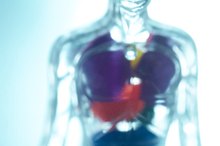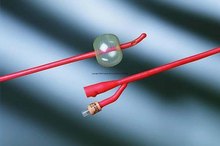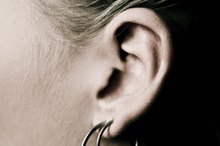How to Remove a Catheter
How to Remove a Catheter. Two major types of urinary catheters exist, the indwelling and Foley catheters. Outpatients primarily handle the care of their indwelling catheter. About 10 to 15 percent of hospital patients have a Foley catheter. Differences between the two call for alternate methods of removal. With the indwelling catheter, there are two methods of removal. With the Foley, complications arise, which hospital physicians handle. The steps below explain removal procedures.
Indwelling Catheter
Locate the inflation port on the catheter's side and attach a small syringe.
How to Use Fleet Enemas Prior to a Prostate Biopsy
Learn More
Draw out the fluid using your syringe until no more fluid can be drawn.
Remove the catheter slowly by gently pulling it out completely.
How to Irrigate Foley Catheters
Learn More
Cut the balloon port tubing, using surgical scissors, as a second alternative to remove your catheter. Wait for all the fluid to drain before slowly pulling out the catheter.
- Locate the inflation port on the catheter's side and attach a small syringe.
Foley Catheter
Advance the catheter to make sure it's in the bladder.
Cut the balloon port at the inflation valve to remove the valve, allowing fluid to drain. If fluid doesn't drain, there likely is an obstruction at the balloon's entrance or along the length of the catheter.
Lubricate a fine-gauge guidewire and then pass it through the inflammation channel. Fluid should drain along the wire.
Pass a 22-gauge central venous catheter over the guidewire if the fluid still hasn't drained. Remove the wire when the catheter tip is in the balloon and it should drain.
Dissolve the balloon using mineral oil if fluid still hasn't drained. Inject 10 ml of mineral oil with a small syringe through the inflation port. Within 15 minutes, the balloon should dissolve.
Inject an additional 10 ml of mineral oil if, after 15 minutes, the balloon hasn't drained.
Tips
Seek medical attention if you can't remove the catheter with only gentle pulling. If you can't urinate within eight hours after removing your catheter, consult your physician. If you have abdominal pain or distension after you remove your catheter, seek medical help. When the catheter balloon doesn't deflate, usually it's due to a malfunction of the inflammation valve. This can happen because of kinking, crushing or external clamping of the inflation channel.
Warnings
Don't use acetone, chloroform or ether to dissolve the balloon, as these compounds can be potentially toxic to the bladder.
- Advance the catheter to make sure it's in the bladder.
- If fluid doesn't drain, there likely is an obstruction at the balloon's entrance or along the length of the catheter.
Related Articles
References
- Håkansson MÅ. Reuse versus single-use catheters for intermittent catheterization: what is safe and preferred? Review of current status. Spinal Cord. 2014;52(7):511-6. doi:10.1038/sc.2014.79
- National Clinical Guideline Centre (UK), Royal College of Physicians (UK). Long term urinary catheters. In: Infection: prevention and control of healthcare-associated infections in primary and community care. London: National Clinical Guideline Centre, 2012.
- Willette PA, Coffield S. Current trends in the management of difficult urinary catheterizations. West J Emerg Med. 2012;13(6):472-8. doi:10.5811/westjem.2011.11.6810
- Cortese YJ, Wagner VE, Tierney M, Devine D, Fogarty A. Review of catheter-associated urinary tract infections and urinary tract models. J Healthc Eng. 2018;2018:2986742. doi:10.1155/2018/2986742
- Urinary catheter types and being part of the insertion team. Agency for Healthcare Research and Quality. Updated April 2017.
- Guide to implementing a program to reduce catheter-associated urinary tract infections in long-term care. Agency for Healthcare Research and Quality. Published March 2017.
- Urinary Catheters. Medline Plus. Updated January 6, 2020.
- Infection control: catheter-associated urinary tract infections. Summary of recommendations. Centers for Disease Control and Prevention. Updated November 5, 2015.
- Feneley RC, Hopley IB, Wells PN. Urinary catheters: history, current status, adverse events and research agenda [published correction appears in J Med Eng Technol. 2016;40(2):59]. J Med Eng Technol. 2015;39(8):459–470. doi:10.3109/03091902.2015.1085600
- Meddings J, Saint S, Fowler KE, et al. The Ann Arbor criteria for appropriate urinary catheter use in hospitalized medical patients: results obtained by using the RAND/UCLA appropriateness method. Ann Intern Med. 2015;162(9 Suppl):S1-34. doi:10.7326/M14-1304
Tips
- Seek medical attention if you can't remove the catheter with only gentle pulling.
- If you can't urinate within eight hours after removing your catheter, consult your physician.
- If you have abdominal pain or distension after you remove your catheter, seek medical help.
- When the catheter balloon doesn't deflate, usually it's due to a malfunction of the inflammation valve. This can happen because of kinking, crushing or external clamping of the inflation channel.
Warnings
- Don't use acetone, chloroform or ether to dissolve the balloon, as these compounds can be potentially toxic to the bladder.
Writer Bio
This article was written by the CareerTrend team, copy edited and fact checked through a multi-point auditing system, in efforts to ensure our readers only receive the best information. To submit your questions or ideas, or to simply learn more about CareerTrend, contact us [here](http://careertrend.com/about-us).








